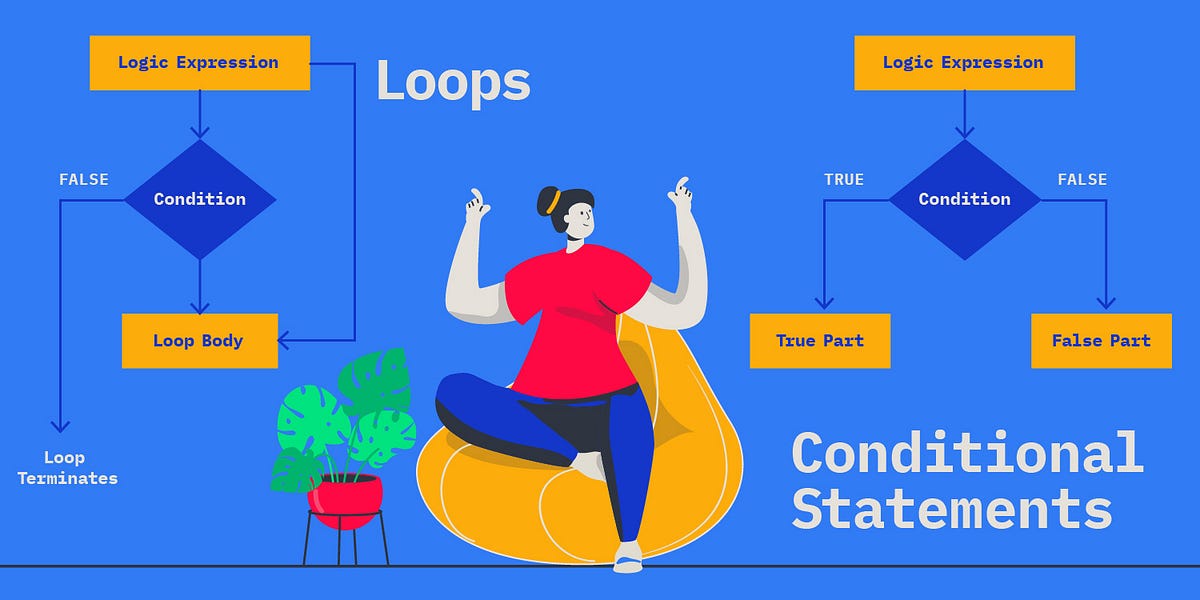Conditional Statements & Loops: A Beginner's Guide for Javascript
 Vineet Raj
Vineet Raj
In every programming language variables , conditionals and loops are the most important topic as it’s difficult to write complex algorithms without these
We are done with variables in previous article
So let’s start cover conditional statement and loops here in this article
Conditional Statements
in javascript or any common programming language we have three type of conditional statements
If Else Statements
if(condition){
// do this
} else{
// do this
}
above given code snippet is structure of a if else block here
if : first scope that will run if condition is true
condition : boolean expression or a boolean variable
If condition or variable has the false value then it will run else block
Example
let flag = true; // a boolean variable
if(flag){
console.log("Value is true"); //output : 'Value is true' // only this code will run
flag = false;
} else{
console.log("Value is false"); //output : 'Value is false'
flag = true;
}
It’s second version is with using else if block
if(cond1){
// code
}else if( cond2 ){
//code
}else{
// code
}
Similar to if-else but has one or more middle blocks with more conditions
example
let marks = 84
if (marks > 90) {
console.log("A+");
} else if (marks > 80) {
console.log("A"); // this blocks gives the output : "A"
} else if (marks > 70) {
console.log("B");
} else if (marks > 60) {
console.log("C");
} else if (marks > 50) {
console.log("D");
} else{
console.log("Fail");
}
We can also write nested if-else condition ( if - else condition inside another if else block )
Switch Case Statements
now in if else we can use any kind of comparison operators but in Switch Case Statement we only focus on strict equality operator
As we pass a simple variable to the switch case statement
then create multiple cases for where we compare value of such variables with different cases using
===and if it matches, we run the code for that code
Works similarly as a switch like you pass electricity to all sockets but only one socket passes electricity the one whose switch is one
structure with example
let day = 3;
switch (day){
case 1 : console.log("Monday");
break;
case 2 : console.log("Tuesday");
break;
case 3 : console.log("Wednesday"); // only this statement will run
break;
case 4 : console.log("Thursday");
break;
case 5 : console.log("Friday");
break;
case 6 : console.log("Saturday");
break;
case 7 : console.log("Sunday");
break;
default: console.log("Invalid day");
}
Assignment : Try running the same code without break; keyword and observe the code
Ternary Operators
Unlike other two conditional statement this one process values on true and false
or say if-else block without any else if condition
But it allows nested ternary conditions
used for conditional assignment
Structure
let myVariable = expression ? output1_if_expression_returns_true : else_output2
examples
let age = 25;
let isAllowedToVote = age >= 18 ? true : false;
console.log(isAllowedToVote) // output is true
let age = 31;
let ageStatus = age >= 15
? age > 19 && age <= 29
? "In his twenties"
: "Not in his twenties"
: "child";
console.log(ageStatus) // output is Not in his twenties
Loops
While coding you stumble upon some problem statement where you to traverse all the numbers or range of given data set from a starting point to end point
in javascript we mainly get 3 loops for performing such actions
For Loop
for(let i = startIndex ; termination_condition ; change_the_value_by ){
//code
}
startIndex: initial value of taken varibaletermination_condition: loop will run till this condition is satisfiedchange_the_value_by: after each iteration value of taken variable will change by the logic written here
Printing a table of 2 using this
for (let i = 1; i <= 10; i =i+ 1) {
console.log("2 X " + i + " = " + i * 2);
}
/**
'2 X 1 = 2'
'2 X 2 = 4'
'2 X 3 = 6'
'2 X 4 = 8'
'2 X 5 = 10'
'2 X 6 = 12'
'2 X 7 = 14'
'2 X 8 = 16'
'2 X 9 = 18'
'2 X 10 = 20'
*/
While loop
let i = startIndex
while(termination_condition){
//code
change_the_value_by;
}
Printing a table of 2 using this in reverse order
let i = 10
while(i > 0){
console.log("2 X " + i + " = " + i * 2);
// i++; // shorthand for i = i+1
i--; // shorthand for i = i-1
}
/*
'2 X 10 = 20'
'2 X 9 = 18'
'2 X 8 = 16'
'2 X 7 = 14'
'2 X 6 = 12'
'2 X 5 = 10'
'2 X 4 = 8'
'2 X 3 = 6'
'2 X 2 = 4'
'2 X 1 = 2'
*/
Do While
let i = startIndex;
do{
// code
change_the_value_by
}while(termination_condition)
Printing a table of 2 using this in reverse order
let i = 10
while(i > 0){
console.log("2 X " + i + " = " + i * 2);
// i++; // shorthand for i = i+1
i--; // shorthand for i = i-1
}
/*
'2 X 10 = 20'
'2 X 9 = 18'
'2 X 8 = 16'
'2 X 7 = 14'
'2 X 6 = 12'
'2 X 5 = 10'
'2 X 4 = 8'
'2 X 3 = 6'
'2 X 2 = 4'
'2 X 1 = 2'
*/
Now we are done with two more important topics conditionals and loops so let’s see in you next article where we will be covering more javascript topics
Subscribe to my newsletter
Read articles from Vineet Raj directly inside your inbox. Subscribe to the newsletter, and don't miss out.
Written by